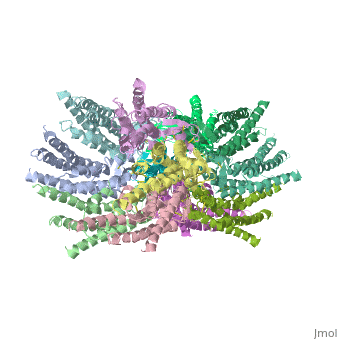Introduction
Connexins are integral transmembrane proteins that form intercellular channels in vertebrates. Connexin 26 is encoded by the GJB2 gene. Six connexins form a hexamerical assembly, known as a connexon or a hemichannel, which form an intercellular gap junction channel. Gap junctions are specialized membrane regions containing hundreds of intercellular communication channels that allow the passage of molecules such as ions, metabolites, nucleotides and small peptides. Virtually all cells in solid tissues are coupled by gap junctions, thus it is not surprising that mutations in connexin genes have been linked to a variety of Connexin human diseases, including cardiovascular anomalies, peripheral neuropathy, skin disorders, cataracts, and deafness.
Of notice, about half of all cases of human pre-lingual recessive deafness in countries surrounding the Mediterranean have been linked to mutations in the GJB2 gene[1],[2]
- Connexin 26 participates in K+ transport in sensory hair cells in the ear and its mutations are causes of deafness[3]
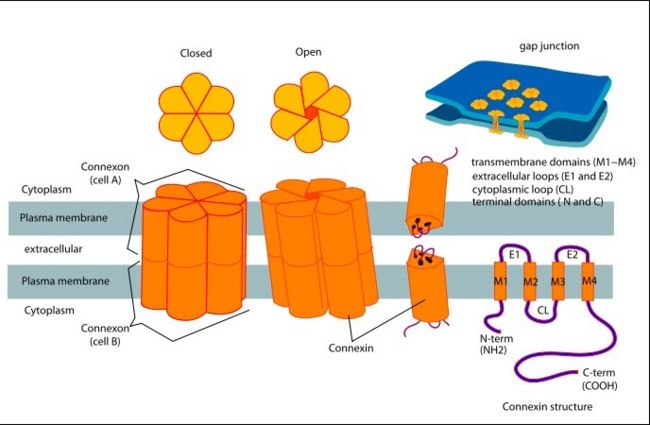
The overall connexon's structure
Phenotypic results of mutations in connexin 26 and hearing loss
Mutations in human Connexin 26 (hCx26) can lead to congenital hearing loss [5] (1 child per 1000 frequency) that can be syndromic or non-syndromic. Non-syndromic hearing loss (NSHL) is characterized by sensorineural hearing loss in the absence of other symptoms, while syndromic hearing loss affects other organ systems, primarily the skin. mutations in GJB2 (the gene that encodes for Cx26) account for about half of all congenital and autosomal recessive nonsyndromic hearing loss in every population tested . Although the most frequently occurring (NSHL) mutations produce severely truncated proteins due to frameshift or missense, almost 80% of the known deafness mutations are actually single amino acid changes or deletions. These mutations have been found across the entire sequence of Cx26. The majority of NSHL mutations cause either generalized folding problems that result in the failure of Cx26 to traffic to the cell surface, or are permissive for the formation of gap junction plaques, but prevent intercellular channel function.[6]
The biochemical function of connexin 26 in the ear
Connexin 26 (CX26) protein is essential for maintaining the high K+ concentration in the endolymph of the inner ear. Sound stimulation of the ossicular chain causes vibrations in the endolymph. K+ ions enter the hair cells under the influence of these vibrations and vibration signal is ultimately converted into a neural signal. The system is regenerated by the release of K+ from the hair cells into the supporting cells. The K+ ions are then passed from cell to cell via gap junctions and are eventually released into the endolymph, Except for sensorineural cells, the CX26 protein is present in gap junctions connecting all cell types in the cochlea, including the spiral limbus, the supporting cells, the spiral ligament and the basal and intermediate cells of the stria vascularis. It is therefore very likely that connexin 26 is involved in K+ recycling in the cochlea.[7]
Structure:
Connexin structure
are integral transmembranal proteins which consist of α-helical domains in the (TM1-TM4), (E1 and E2), a cytoplasmic loop, an N-terminal helix (NTH), and a C-terminal segment. Each connexin consists of 227 amino acids, and form a hexamerical assembly, known as , or a , which delineates with a minimum diameter of ∼1.2 nm.
When two hemichannels from adjacent cells dock and join, leaving a gap of ∼2–3 nm, they may form a gap junction which spans the two plasma membranes and allows the exchange of cytoplasmic molecules with size up to ∼1 kDa.
The transmembrane region of the channel is 38Å thick. TM2 extends about 19Å from the membrane surface into the cytoplasm. The extracellular region of the connexon extends 23Å from the membrane surface and interdigitates to the opposite connexon by 6Å, resulting in the intercellular ‘gap’ of 40Å. The extracellular lobes are not protruding so much, as indicated by the structural analyses of split gap junction channels with atomic force microscopy and electron microscopy. The relatively flat lobes could be attributed to the conformational change of the extracellular region induced by the docking of two connexons. The diameter of the connexon is biggest at the cytoplasmic side of the membrane, 92Å , and smallest at the extracellular side, 51Å .
Viewed from the top, the channel looks like a ‘hexagonal nut’ with a pore in the centre .The diameter of the pore is about 40Å at the cytoplasmic side of the channel, narrowing to 14Å near the extracellular membrane surface and then widening to 25Å in the extracellular space.[2]
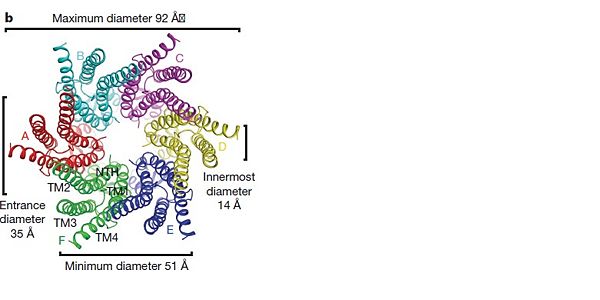
Top view of the Cx26 gap junction channel
Structure of the cx26 protomer:
As mentioned before protomer has four transmembrane (TM1–4), two extracellular loops, a cytoplasmic loop, an N-terminal helix (NTH), and a C-terminal segment. Cx26 forms a typical four-helix bundle in which any pair of adjacent helices is antiparallel. The major pore-lining helix TM1 is inclined, so that the pore diameter narrows from the cytoplasmic to the extracellular side of the membrane, and ends in a short 310 helix.
The extracellular loop E1 contains a
310 helix at the beginning and a short α-helix in its C-terminal. E2, together with E1, contains a short antiparallel β-sheet and stretches over E1, forming the outside of the connexon. Six conserved cysteine residues, three in each loop, form intramolecular disulphide bonds between E1 and E2 Most of the prominent intra-protomer interactions are in the extracellular part of the transmembrane region, The interactions between the two adjoining connexons of the gap junction channel, which involve both E1 and E2.
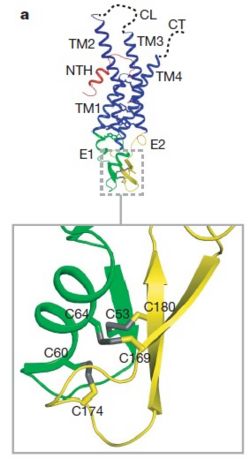
Disulfide bonds between two extracellular loops in the Cx26 promoter
The N-terminal half of E2 seems rather flexible and its amino-acid sequence varies greatly among connexins. The C-terminal half of E2 begins with a 310 turn is followed by a conserved Pro-Cys-Pro motif that reverses its direction back to TM4. Most of the prominent intra-protomer interactions are in the extracellular part of the transmembrane region. Arg 32 (TM1) interactswithGln 80 (TM2), Glu 147 (TM3) and Ser 199 (TM4). Two hydrophobic cores around Trp 44 (E1) and Trp 77 (TM2) stabilize the protomer structure. Ala 39 (TM1), Ala 40 (TM1), Val 43 (E1) and Ile 74 (TM2) contribute to the first hydrophobic core around Trp 44, and Phe 154 (TM3) and Met 195 (TM4) form the second core with Trp 77. In the intracellular part of the transmembrane region, Arg 143 (TM3) forms hydrogen bonds with Asn 206 (TM3) and Ser 139 (TM3).[2]
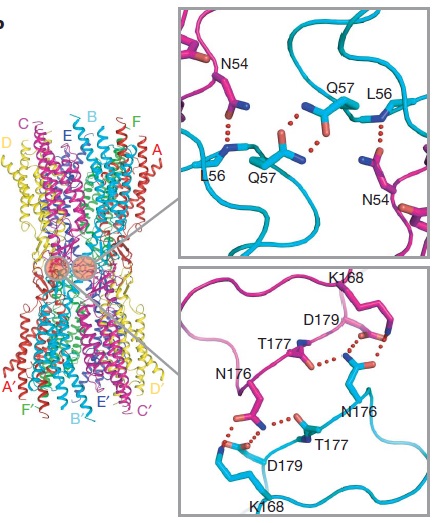
Intracellular interactions
Differences between wild type and mutant connexin 26
In general, single site mutations are spread fairly evenly across the whole protein with TM2 having the highest mutation density (number of amino acids with NHLS mutations divided by the total number of amino acids in the domain) at 67% to M1 and E1, having the lowest density of mutations with their respective domains at 33%. According to this criterion, TM4 has a mutation density of 40%. Of the four transmembrane helices, M1, M2 and M3 have attracted the most attention, because of the controversies involved in models with different helix assignments, based on lower resolution cryo-electron crystallographic structures and scanning cysteine accessibility mutagenesis. Far less is known about TM4 and how side chains interact with the other helices and with the lipid bilayer.[6]
Two structural crystallographic studies have been commenced on Cx26, the first one describing the WT protein in a resolution of 3.5 Å by Tsuhikara, T.(2009)[2], and the second one deals with two types of mutations in the N terminus of the protein by Fujiyoshi, Y.(2011).[8]
Gap junction channels are unique in that they possess multiple mechanisms for channel closure, several of which involve the (blue coloured) as a key component in gating, and possibly assembly. [8]
The 3D structure of a mutant human connexin 26 channel shows an unexpected density within the vestibule of each hemichannel compared to the , which is called a plug [8] , That plug was decreased in the the human mutant connexin 26 structure, indicating that the N terminus significantly contributes to form this plug feature. Experiments with this mutant show significantly reduced dye coupling between HeLa cells transiently expressing Cx26M34A gap junctions. [8]
Functional analysis of the Cx26M34A channels revealed that these channels are predominantly closed, with the residual electrical conductance showing normal voltage gating. N-terminal deletion mutants with and without the M34A mutation showed no electrical activity in paired Xenopus oocytes and significantly decreased dye permeability in HeLa cells. Comparing this closed structure with the published X-ray structure of wild-type Cx26, which is proposed to be in an open state, revealed a radial outward shift in the transmembrane helices in the closed state, presumably to accommodate the N-terminal plug occluding the pore. Because both Cx26del2-7 and Cx26M34Adel2-7 channels are closed, the N terminus appears to have a prominent role in stabilizing the open configuration. [8]
3D structures of connexin
Connexin 3D structure
